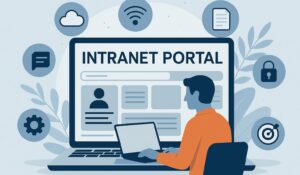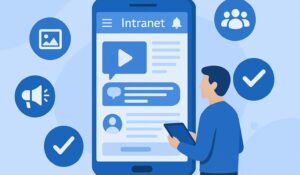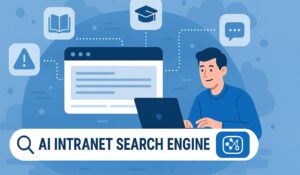Modern organizations rely on their intranet to store sensitive files, manage communications, and connect global teams. However, as cyberthreats evolve and hybrid work expands, intranet security is no longer optional—it’s mission-critical.
A secure intranet software protects data, ensures compliance, and keeps employees connected without exposing the organization to risks. Therefore, whether you’re evaluating cloud-based intranet platforms or considering on-premise systems, this guide will walk you through the latest best practices, compliance needs, industry benchmarks, and secure intranet vendors in 2026.
👉 Deep dive with our intranet software guide and explore our employee intranet platform.
What Is Intranet Security?
Intranet security refers to the policies, technologies, and processes that protect an organization’s internal network from unauthorized access, data leaks, and cyberattacks. Moreover, a secure intranet supports compliance and ensures that collaboration remains safe.
Common threats to an intranet:
- Unauthorized access from weak passwords or poor permissions
- Phishing attacks targeting employees
- Insider risks from disgruntled staff or careless behavior
- Outdated systems lacking patches and monitoring
A secure intranet defends against these risks while still enabling seamless file sharing, collaboration, and employee communication.
📊 IBM’s Cost of a Data Breach 2024 reports an average global breach cost of $4.88M (up from $4.45M), while Verizon’s DBIR 2024 finds 68% of breaches involve the human element—underscoring why a secure intranet with strong access controls and employee awareness is essential.
Key Layers of a Secure Intranet
The most effective intranet security model follows a defense-in-depth framework, layering protections across the network, application, identity, data, and user levels. Consequently, each layer reinforces the others to provide holistic protection.
1. Network Security
- Firewalls, VPNs, and intrusion detection
- Segmented access for remote users
2. Application Security
- Continuous patching and vulnerability scans
- Secure development practices (DevSecOps)
3. Identity & Access Management
- MFA (multi-factor authentication)
- SSO (single sign-on) for simplified but secure access
- RBAC (role-based access control)
4. Data Security
- End-to-end encryption (at rest and in transit)
- Secure file sharing with expiry links
5. User Awareness
- Phishing simulations
- Security awareness training
Core Features of a Secure Intranet Platform:
MFA, SSO, encryption, audit trails, data compliance certifications, and automated patching.
Advanced Security Controls Most Buyers Now Expect
To go beyond the basics, secure intranet platforms increasingly include advanced controls. Furthermore, these enhancements align with enterprise security expectations and regulatory frameworks.
- Identity, SSO & Provisioning: SAML/OIDC SSO (Okta, Azure AD, Google), SCIM user provisioning/deprovisioning, JIT access, session management, IP allowlisting, device posture checks, and conditional access.
- Access Governance: Fine-grained RBAC down to site/page/file/comment level; temporary/just‑in‑time elevation; approval workflows; guest/external user policies with expiring links and watermarking.
- Data Protection: AES‑256 encryption at rest; TLS 1.2+ in transit; key rotation; support for customer-managed keys (CMK) via cloud KMS; content DLP (download/print restrictions), redaction, retention & legal hold.
- Monitoring & Integrations: Audit trails with export APIs; SIEM integrations (e.g., Splunk, Sentinel); CASB/SASE support; anomaly detection and alerting.
- Resilience: RPO/RTO targets, immutable backups, geo-redundancy, routine restore tests; documented incident response playbooks.
- Data Residency & Sovereignty: Ability to select EU or US hosting and keep data in-region; transparent subprocessor lists and SLAs.
- Zero Trust posture: Least‑privilege by default, continuous verification, and micro‑segmentation across services.
Secure Intranet Checklist: Best Practices
Here’s a practical checklist to evaluate whether your intranet platform is secure. Additionally, it provides a quick reference guide for IT and compliance leaders:
✅ Regular updates and patch management
✅ Endpoint protection for remote devices
✅ Role-based access and least-privilege policies
✅ MFA and SSO enabled
✅ Audit logging and activity monitoring
✅ Data encryption at rest & in transit
✅ Compliance certifications (ISO 27001, SOC2, GDPR, HIPAA if needed)
✅ User training and awareness campaigns
Secure Intranet Software & Platforms
Not all intranet vendors are created equal. Therefore, a secure intranet platform is defined by how it handles hosting, data protection, compliance, and access.
What makes intranet software secure?
- Vendor offers ISO 27001 / SOC 2 Type II attestation and will share reports under NDA
- Hosting in trusted environments (AWS, Azure, GCP) with shared-responsibility clarity
- Built‑in MFA, SSO, encryption, and granular permissions
- Penetration testing, vulnerability management, and a documented security program
- Clear data residency, DPA, and incident response commitments
If you’re shortlisting vendors, prioritize evidence (audits, policies, pentest summaries) over claims. In addition, evaluate how vendors demonstrate transparency through Trust Centers or documentation.
👉 See our guide on how to pick intranet providers.
Cloud vs On-Prem Intranet Security
A key decision is whether to host your intranet in the cloud or keep it on-premise. Both have pros and trade-offs. However, understanding these differences helps organizations make informed choices.
| Feature | Cloud SaaS Intranet Security | On-Prem Intranet Security |
|---|---|---|
| Updates & Patching | Automatic, vendor-managed | Manual, IT team responsibility |
| Compliance | Vendor holds certifications (SOC2, ISO) | Organization must maintain/renew audits |
| Scalability | Rapid, global | Limited to infrastructure capacity |
| Access Control | MFA/SSO, conditional access built-in | Custom setup needed |
| Data Residency | Often offers EU/US region choice | Determined by your data centers |
| Encryption Keys | Cloud KMS/CMK options; rotation policies | You implement/manage KMS and rotation |
| Private Networking | Options like Private Link/VPN | Native, but you design/maintain |
| DDoS Protection | Cloud provider + vendor controls | Your stack and tooling |
| Resilience (RPO/RTO) | Documented SLAs and geo-redundancy | Depends on your DR design |
| Cost | Subscription-based | Higher upfront hardware + ongoing ops |
👉 Read more on the benefits of cloud based intranets.
Intranet Security Audits & Reviews
Security isn’t one-and-done. Consequently, organizations should run annual or semi-annual intranet security audits, including:
- External penetration testing and remediation proof
- Access and permissions recertification (quarterly for high-risk roles)
- Policy compliance checks (password/MFA, data retention, DLP)
- Backup & recovery tests against RPO/RTO targets
- Vendor risk review (subprocessors, data residency, incident history)
Bonus: Maintain a vulnerability disclosure/bug bounty process and publish uptime & security metrics in a Trust Center. Furthermore, communicate audit outcomes to leadership to ensure accountability.
Compliance & Certifications
A secure intranet platform helps organizations meet strict compliance standards, including:
- GDPR (data privacy for EU users)
- HIPAA (healthcare data)
- ISO 27001 (information security management)
- SOC 2 Type II (service organization controls)
- DPA (Data Processing Agreements) under GDPR Art. 28 to define controller/processor responsibilities and subprocessors
- EU–U.S. Data Privacy Framework (DPF) participation for lawful EU→US data transfers (or SCCs/alt. mechanisms when preferred), plus clear data residency options
Tip: Always request documentation from your intranet vendor (certificates, SOC 2 report under NDA, DPA, subprocessor list, and DPF listing) to validate these commitments. In addition, confirm whether the vendor maintains an external Trust Center for transparency.
Conclusion: Building a Truly Secure Intranet
A secure intranet platform combines strong technology, clear policies, and an informed workforce. From MFA and encryption to compliance certifications and regular audits, intranet security must be layered, continuous, and future-ready. Therefore, it should be seen as a shared responsibility across IT, compliance, and employee groups.
👉 Ready to protect your organization? Get a demo of our secure intranet platform.
FAQs
What is intranet security?
Intranet security refers to the tools, policies, and processes that protect an organization’s internal network from threats, ensuring safe collaboration and data sharing. Moreover, it provides a structured approach to safeguard sensitive data.
What is secure intranet software?
Secure intranet software is a platform built with encryption, access control, MFA/SSO, and compliance certifications to protect sensitive employee and organizational data. Additionally, it integrates with identity providers to simplify secure access.
What features make an intranet platform secure?
MFA, SSO, encryption, audit logging, patch management, compliance support, and role-based permissions. Furthermore, leading platforms also support data residency and advanced monitoring.
How do you secure an intranet from external threats?
Use firewalls, VPNs, intrusion detection, MFA, and ongoing employee training to reduce phishing and unauthorized access. In addition, perform regular penetration tests to validate your defenses.
Which is more secure: cloud or on-prem intranet?
Both can be secure, but cloud platforms usually provide automatic updates and certifications, while on-prem requires IT resources to maintain security. However, cloud solutions often scale faster and reduce operational overhead.
How often should intranet security be reviewed?
At least once per year, but ideally every 6 months with penetration testing and policy compliance checks. Furthermore, periodic entitlement reviews help reduce risks associated with access sprawl.













